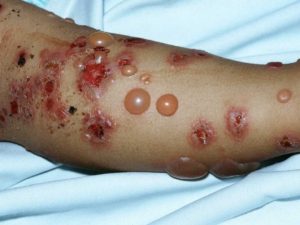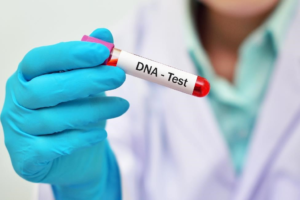Bullous Pemphigoid (BP) Samples
Bay Biosciences provides high quality, clinical grade bio-samples, cryogenically preserved biopsy tissue, FFPE blocks, sera (serum), plasma and peripheral blood mononuclear cells (PBMC) biofluid specimens from patients diagnosed with Bullous Pemphigoid (BP) disease.
The sera (serum), plasma and peripheral blood mononuclear cells (PBMC) biofluid specimens are processed from Bullous Pemphigoid (BP) patient’s peripheral whole-blood using customized collection and processing protocols. The Bullous Pemphigoid (BP) biopsy tissue and matched biofluid samples are collected from unique patients diagnosed with Bullous Pemphigoid (BP) and are provided to a valued pharmaceutical customer for research, diagnostics, discovery and drug development.
Detailed clinical data, patient’s history, symptoms, complete blood count (CBC), serology, MRI, biopsy tissue findings, histopathology information, elevated biomarker levels, genetic and metabolic information associated with the Bullous Pemphigoid (BP) samples is provided to a valued customer for research, development and drug discovery.
The Bullous Pemphigoid (BP) sera (serum), plasma and urine biofluids are processed using customized collection, processing and storage protocols.
Bullous Pemphigoid Overview

Bullous Pemphigoid is a rare autoimmune skin (sub-epidermal) disease that causes large, fluid-filled blisters. They develop on areas of skin that often flex, such as the lower abdomen, upper thighs or armpits. Bullous pemphigoid is most common in patients older male and female adults. Bullous pemphigoid often occurs in people over 80 years of age, and mostly affects people over 50.
Bullous pemphigoid occurs when the immune system attacks a thin layer of tissue below the outer layer of skin. The reason for this abnormal immune response is unknown, although it sometimes can be triggered by taking certain medications. Bullous Pemphigoid is the result of an attack on the basement membrane of the epidermis by IgG +/- IgE immunoglobulins antibodies and activated T-lymphocytes, white blood cells. The target is the protein BP180, also called Type XVII collagen, or less frequently BP230, a plakin. These proteins are within the NC16A domain of collagen XVII. They are associated with the hemidesmosomes, structures that ensure the epidermal keratinocyte cells stick to the dermis to make a waterproof seal.
Signs and Symptoms of Bullous Pemphigoid
The signs and symptoms of Bullous Pemphigoid (BP) may include:
- Itching skin, weeks or months before blisters form
- Large blisters that don’t easily rupture when touched, often along creases or folds in the skin
- Skin around the blisters that is normal, reddish or darker than normal
- Eczema or a hive-like rash
- Small blisters or sores in the mouth or other mucous membranes (benign mucous membrane pemphigoid)
Other variable features include:
- Nonspecific rash for several weeks before blisters appear
- Eczematous areas resembling nummular dermatitis
- Urticaria-like red skin
- Annular, ring-shaped lesions
- Smaller blisters, vesicles
- Prurigo nodules, Pemphigoid Nodularis
- Clear or cloudy, yellowish or bloodstained blister fluid
- Post-Inflammatory Pigmentation
- Milia (small bump like cyst) in healed areas
Bullous Pemphigoid may be localized to one area, or widespread on the trunk and proximal limbs, frequently it affects the skin around skin folds, blisters inside the mouth and in genital sites are uncommon. Some patients have a diagnosis of Bullous Pemphigoid made despite not having any bullae (Non Bullous Pemphigoid), this can affect any site on the body.

Causes of Bullous Pemphigoid
The blisters occur because of a malfunction in the immune system. The body’s immune system normally produces antibodies to fight bacteria, viruses or other potentially harmful foreign substances. For reasons that are not clear, the body may develop an antibody to a particular tissue in the body. In Bullous Pemphigoid (BP) disease, the immune system produces antibodies to the fibers that connect the outer layer of skin (epidermis) and the next layer of skin (dermis). These antibodies trigger inflammation that produces the blisters and itching of Bullous Pemphigoid.
Bullous Pemphigoid usually appears randomly with no clear factors contributing to the onset of disease. Some cases may be triggered by:
- Medications: Prescription drugs may cause Bullous Pemphigoid (BP) disease.
- Light and radiation: Ultraviolet (UV) light therapy to treat certain skin conditions may trigger Bullous Pemphigoid disease, as can radiation therapy to treat cancer.
- Medical conditions: Diseases that may trigger Bullous Pemphigoid include psoriasis, lichen planus, diabetes, rheumatoid arthritis, ulcerative Colitis and multiple sclerosis.

Bay Biosciences is a global leader in providing researchers with high quality, clinical grade, fully characterized human tissue samples, bio-specimens and human bio-fluid collections from cancer (tumor) tissue, cancer serum, cancer plasma cancer PBMC and human tissue samples from most other therapeutic areas and diseases.
Bay Biosciences maintains and manages it’s own bio-repository, human tissue bank (biobank) consisting of thousands of diseased samples (specimens) and from normal healthy donors available in all formats and types. Our biobank procures and stores fully consented, deidentified and institutional review boards (IRB) approved human tissue samples and matched controls.
All our human human tissue collections, human specimens and human bio-fluids are provided with detailed samples associated patient’s clinical data. This critical patient’s clinical data includes information relating to their past and current disease, treatment history, lifestyle choices, biomarkers and genetic information. Patient’s data is extremely valuable for researchers and is used to help identify new effective treatments (drug discovery & development) in oncology, other therapeutic areas and diseases. This clinical information is critical to demonstrate their impact, monitor the safety of medicines, testing & diagnostics, and generate new knowledge about the causes of disease and illness.
Bay Biosciences banks wide variety of human tissue samples and biological samples including cryogenically preserved -80°C, fresh, fresh frozen tissue samples, tumor tissue samples, FFPE’s, tissue slides, with matching human bio-fluids, whole blood and blood derived products such as serum, plasma and PBMC’s.
Bay Biosciences is a global leader in collecting and providing human tissue samples according to the researchers specified requirements and customized, tailor made collection protocols. Please contact us anytime to discuss your special research projects and customized human tissue sample requirements.
Bay Biosciences provides human tissue samples (human specimens) from diseased and normal healthy donors; including peripheral whole-blood, amniotic fluid, bronchoalveolar lavage fluid (BAL), sputum, pleural effusion, cerebrospinal fluid (CSF), serum (sera), plasma, peripheral blood mononuclear cells (PBMC’s), saliva, Buffy coat, urine, stool samples, aqueous humor, vitreous humor, kidney stones, renal calculi, nephrolithiasis, urolithiasis and other bodily fluids from most diseases including cancer. We can also procure most human bio-specimens and can do special collections and requests of human samples that are difficult to find. All our human tissue samples are procured through IRB approved clinical protocols and procedures.
In addition to the standard processing protocols Bay Biosciences can also provide human plasma, serum, PBMC bio-fluid samples using custom processing protocols, you can buy donor specific sample collections in higher volumes and specified sample aliquoting from us. Bay Biosciences also provides human samples from normal healthy donors, volunteers, for controls and clinical research, contact us Now.
日本のお客様は、ベイバイオサイエンスジャパンBay Biosciences Japanまたはhttp://baybiosciences-jp.com/contact/までご連絡ください。


